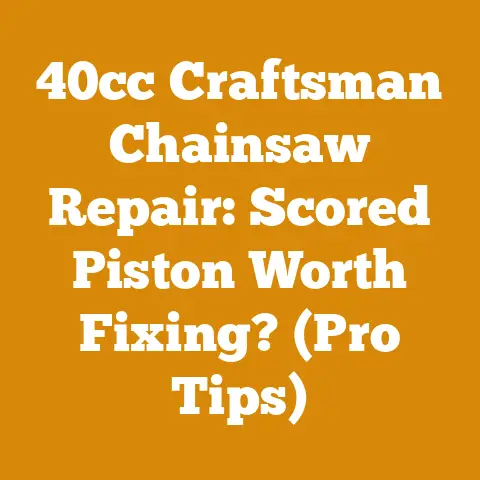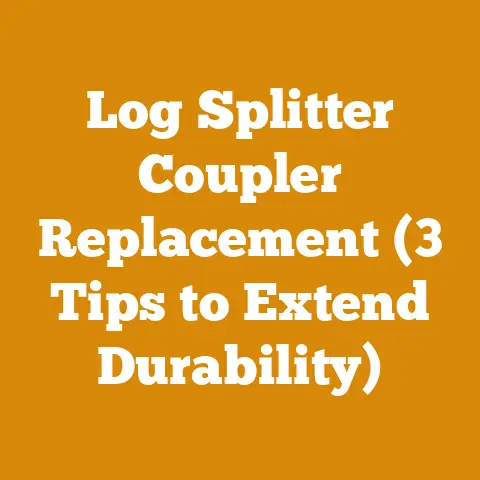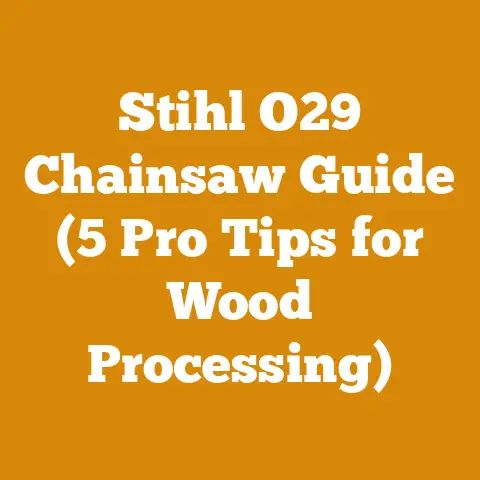Lenz CP-752-30 Filter Guide (5 Pro Tips for Longer Splitter Life)
Are you tired of your log splitter constantly breaking down, leaving you with a pile of unsplit wood and a whole lot of frustration? I know I was. For years, I struggled with hydraulic issues, leaky seals, and an overall lack of power. It felt like I was spending more time repairing my splitter than actually splitting wood. Then, I discovered the importance of proper filtration, specifically the Lenz CP-752-30 filter. Implementing a few key strategies around this filter dramatically extended the life of my splitter and saved me a ton of money in the long run. This guide is designed to share those secrets with you, so you can spend less time wrenching and more time enjoying a warm fire.
Lenz CP-752-30 Filter Guide: 5 Pro Tips for Longer Splitter Life
The Lenz CP-752-30 filter is a crucial component in your log splitter’s hydraulic system. It’s responsible for removing contaminants from the hydraulic fluid, preventing damage to the pump, valves, and cylinders. Neglecting this small but mighty filter can lead to significant and costly repairs. In this guide, I’ll share five pro tips, honed over years of hands-on experience, to help you maximize the life of your log splitter by properly utilizing the Lenz CP-752-30 filter.
1. Understand Your Hydraulic System and the Filter’s Role
Before diving into the tips, let’s ensure we understand the basics. The hydraulic system in your log splitter uses pressurized fluid to generate the force needed to split wood. This fluid circulates continuously, picking up contaminants like dirt, metal shavings, and moisture. These contaminants are the enemy of your hydraulic components.
The Lenz CP-752-30 filter acts as a gatekeeper, trapping these particles before they can cause damage. It’s typically a spin-on filter, meaning it’s easily replaceable. The “CP-752-30” designation refers to the filter’s specific dimensions and filtration rating. The “-30” usually indicates a 30-micron filtration level, meaning it can capture particles 30 microns in size or larger. To put that in perspective, a human hair is about 70 microns thick.
Why is this important? Understanding the filter’s role helps you appreciate its significance and motivates you to maintain it properly. Imagine running your car without an oil filter – the engine would quickly seize up. The same principle applies to your log splitter’s hydraulic system.
Takeaway: The Lenz CP-752-30 filter is your hydraulic system’s first line of defense against damaging contaminants. Understanding its purpose is the foundation of proper maintenance.
2. Establish a Regular Filter Replacement Schedule
This is where many people fall short. They wait until they notice a problem – like reduced splitting power or jerky cylinder movement – before thinking about the filter. By then, the damage is often already done. A proactive approach is key.
My Rule of Thumb: I recommend replacing the Lenz CP-752-30 filter at least every 50 hours of operation, or annually, whichever comes first. This is a general guideline, and the ideal replacement frequency may vary depending on your operating conditions.
Factors Affecting Replacement Frequency:
- Wood Type: Splitting dirty or resinous wood can introduce more contaminants into the system.
- Operating Environment: Working in dusty or muddy conditions increases the risk of contamination.
- Hydraulic Fluid Quality: Using a lower-quality fluid can lead to increased wear and tear, generating more particles.
- Splitter Age: Older splitters may have worn seals and components, contributing to contamination.
How to Track Operating Hours:
- Hour Meter: If your splitter has an hour meter, use it to track usage.
- Maintenance Log: Keep a written log of your splitting sessions, noting the date, duration, and type of wood processed.
- Calendar Reminders: Set reminders on your phone or calendar to prompt filter replacements.
The Cost-Benefit Analysis: A Lenz CP-752-30 filter typically costs between $15 and $30. Replacing it regularly is a small price to pay compared to the cost of replacing a hydraulic pump (hundreds of dollars) or repairing a damaged cylinder (potentially even more).
Personal Story: I once neglected my filter replacement schedule and ended up with a clogged valve. The repair cost me over $200 and put my splitter out of commission for a week. I learned my lesson the hard way – regular filter replacements are non-negotiable.
Takeaway: Establish a regular filter replacement schedule based on your operating conditions and track your usage diligently. The relatively low cost of a new filter is a worthwhile investment in the longevity of your log splitter.
3. Choose the Right Hydraulic Fluid and Maintain Proper Levels
The hydraulic fluid is the lifeblood of your log splitter. Using the wrong type or neglecting fluid levels can significantly shorten the life of your hydraulic components and the effectiveness of the filter.
Selecting the Right Fluid:
- Consult Your Owner’s Manual: Your owner’s manual will specify the recommended hydraulic fluid type and viscosity. This is the most important guideline to follow.
- AW-32 or AW-46: Most log splitters use either AW-32 or AW-46 hydraulic fluid. AW stands for “Anti-Wear,” indicating that the fluid contains additives to protect against wear and tear. The number refers to the fluid’s viscosity – its resistance to flow. AW-32 is thinner than AW-46.
- Temperature Considerations: In colder climates, AW-32 may be preferable because it flows more easily at lower temperatures. In warmer climates or for heavy-duty applications, AW-46 may be a better choice.
- Synthetic vs. Mineral-Based: Synthetic hydraulic fluids offer superior performance and longer life compared to mineral-based fluids. However, they are also more expensive. If you’re willing to invest a bit more upfront, a synthetic fluid can provide better protection and extend the life of your splitter.
Maintaining Proper Fluid Levels:
- Check Regularly: Check the hydraulic fluid level before each use. The fluid reservoir should have a dipstick or sight glass to indicate the proper level.
- Fill to the Correct Level: Add fluid as needed to maintain the level within the specified range. Overfilling can cause leaks and damage to the system.
- Bleed Air From the System: After adding fluid, it’s important to bleed any air from the system. Consult your owner’s manual for the proper bleeding procedure. Air in the system can cause jerky operation and reduced splitting power.
Fluid Contamination:
- Use Clean Funnels and Containers: When adding hydraulic fluid, always use clean funnels and containers to avoid introducing contaminants.
- Store Fluid Properly: Store hydraulic fluid in a sealed container in a clean, dry place.
Original Insight: I’ve found that using a high-quality hydraulic fluid with anti-foaming additives is particularly beneficial. Foaming can reduce the fluid’s lubricating properties and lead to cavitation (the formation of vapor bubbles) in the pump, which can cause significant damage.
Takeaway: Choose the right hydraulic fluid based on your owner’s manual and operating conditions. Maintain proper fluid levels and take precautions to prevent contamination. A little attention to detail here can go a long way in extending the life of your log splitter.
4. Inspect and Maintain the Filter Housing and Connections
The Lenz CP-752-30 filter doesn’t operate in isolation. Its effectiveness depends on the condition of the filter housing and its connections. Leaks or damaged components can compromise the system’s integrity and allow contaminants to bypass the filter.
Regular Inspections:
- Check for Leaks: Inspect the filter housing and connections for leaks before each use. Look for signs of fluid weeping or dripping.
- Inspect for Damage: Check the housing for cracks, dents, or other damage. Even minor damage can weaken the housing and make it susceptible to leaks.
- Tighten Connections: Ensure that all connections are tight and secure. Loose connections can allow air to enter the system or fluid to leak out.
Maintenance Procedures:
- Clean the Filter Housing: Before installing a new filter, clean the filter housing with a clean rag. Remove any dirt, debris, or old gasket material.
- Lubricate the Gasket: Lightly lubricate the new filter’s gasket with hydraulic fluid before installation. This will help ensure a proper seal.
- Tighten the Filter Properly: Tighten the filter to the manufacturer’s specifications. Overtightening can damage the gasket or housing. Use a filter wrench for proper leverage.
- Replace Damaged Components: If you find any damaged components, such as the filter housing, connections, or hoses, replace them immediately.
Case Study: I once had a small crack in my filter housing that I didn’t notice. Over time, the crack grew larger, and the system started leaking fluid. Eventually, the pump ran dry and seized up. The cost of replacing the pump was significantly higher than the cost of replacing the filter housing.
Preventative Measures:
- Protect the Filter Housing: Consider installing a protective guard around the filter housing to prevent damage from impacts.
- Use Quality Replacement Parts: When replacing components, use high-quality replacement parts that meet or exceed the original manufacturer’s specifications.
Takeaway: Regularly inspect and maintain the filter housing and connections. Address any leaks or damage promptly to prevent more serious problems. A little preventative maintenance can save you a lot of money and downtime in the long run.
5. Implement Best Practices for Hydraulic System Cleanliness
Even with a properly maintained filter, contaminants can still enter the hydraulic system. Implementing best practices for cleanliness can significantly reduce the amount of debris that reaches the filter, extending its life and protecting your hydraulic components.
Key Areas to Focus On:
- Hydraulic Fluid Handling:
- Cleanliness is Paramount: Always use clean funnels, containers, and tools when handling hydraulic fluid.
- Proper Storage: Store hydraulic fluid in sealed containers in a clean, dry environment to prevent contamination.
- Avoid Mixing Fluids: Never mix different types of hydraulic fluid. This can lead to incompatibility issues and reduced performance.
- Component Installation and Maintenance:
- Clean Work Area: Before working on any hydraulic components, clean the surrounding area to prevent dirt and debris from falling into the system.
- Cap Open Lines: When disconnecting hydraulic lines, immediately cap them to prevent contaminants from entering.
- Use New Seals and Gaskets: Always use new seals and gaskets when reassembling hydraulic components. Old seals can be brittle and prone to leaking.
- Log Splitting Practices:
- Clean Wood: Whenever possible, split clean wood that is free of dirt, mud, and bark.
- Avoid Ground Contact: Try to avoid allowing the hydraulic cylinder to come into direct contact with the ground. This can introduce contaminants into the system.
- Regular Cleaning: Periodically clean the log splitter, especially around the hydraulic components, to remove accumulated dirt and debris.
Unique Insight: I’ve found that using a vacuum cleaner to remove dirt and debris from around the hydraulic components is very effective. This prevents the debris from falling into the system when you’re working on it.
Dealing with Existing Contamination:
- Hydraulic System Flush: If you suspect that your hydraulic system is heavily contaminated, consider performing a system flush. This involves circulating a cleaning fluid through the system to remove debris. Consult your owner’s manual or a qualified technician for the proper procedure.
- Filter Changes After Flushing: After flushing the system, change the hydraulic filter more frequently for the first few operating hours to remove any remaining contaminants.
Takeaway: Implement best practices for hydraulic system cleanliness to minimize contamination. This will extend the life of your filter and protect your hydraulic components. A little extra care and attention can make a big difference in the long run.
Conclusion:
Maintaining your log splitter’s hydraulic system and specifically focusing on the Lenz CP-752-30 filter doesn’t have to be a daunting task. By understanding its role, establishing a regular replacement schedule, choosing the right fluid, maintaining the filter housing, and implementing best practices for cleanliness, you can significantly extend the life of your splitter and save yourself a lot of time, money, and frustration. Remember, preventative maintenance is always cheaper and easier than repairs. So, take care of your filter, and it will take care of your splitter. Now, get out there and split some wood!






